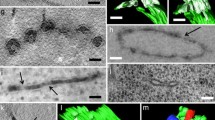Summary
The differentiation of the secretory cavities of Ginkgo stem and the structural organization of the epithelial cells were followed by light and electron microscopy. The mode of formation of the cavities is schizo-lysigeneous. Functional complexes of leucoplasts and associated endoplasmic reticulum (ER) membranes are assumed to be the site of synthesis and translocation of the lipophilic secretory product. Most of the endoplasmic reticulum membranes are paired. The content of the cavities was directly collected and analysed by low- and high-resolution mass spectrometry. The cavities contain anacardic acids and cardanols, which are long-chain phenol lipids not characteristic of Ginkgo. The relationship between the plastid/ER complexes and the production of these secondary metabolites is discussed.
Similar content being viewed by others
References
Ameele RJ (1980) Developmental anatomy of secretory cavities in the microsporophylls of Ginkgo biloba. Am J Bot 67: 912–917
Asakawa Y, Masiya T, Tori M, Campbell EO (1987) Long chain alkyl phenols from the liverwort Schistochila appendiculata. Phytochemistry 26: 735–738
Boralle N, Braquet P, Gottlieb OR (1988) Ginkgo biloba. A review of its chemical composition. In: Braquet P (ed) Ginkgolides: chemistry, biology, pharmacology and clinical perspectives, vol 1. Prous Barcelona Spain, pp 9–25
Bosabalidis A, Tsekos I (1982) Ultrastructural studies on the secretory cavities of Citrus deliciosa Ten. I. Early stages of the gland cells differentiation. Protoplasma 112: 55–62
Carde JP (1984) Leucoplasts: a distinct kind of organelle lacking typical 70S ribosomes and free thylakoids. Eur J Cell Biol 34: 18–26
Carde JP (1987) Electron microscopy of plant cell membranes. In: Packer L, Douce R (eds) Plant cell membranes, Academic Press, New York, pp 599–622
Charon J, Launay J, Carde JP (1987) Spatial organization and volume density of leucoplasts in pine secretory cells. Protoplasma 138: 45–53
Cheniclet C, Carde JP (1985) Presence of leucoplasts in secretory cells and of monoterpenes in the essential oil: a correlative study. Isr J Bot 34: 219–238
Fahn A, Evert RF (1974) Ultrastructure of the secretory ducts of Rhus glabra L. Am J Bot 61: 1–14
Findlay GH, Whiting DA, Eggers SH, Ellis RP (1974) Smodingium (African “poison ivy”) dermatitis. Br J Dermatol 90: 535–541
Gellerman JL, Anderson WH, Schlenk H (1976a) 6-(Pentadec-8-enyl)-2,4-dihydroxybenzoic acid from seeds of Ginkgo biloba. Phytochemistry 15: 1959–1961
Gellerman JL, Anderson WH, Schlenk H (1976b) Synthesis of anacardic acids in seeds of Ginkgo biloba. Biochim Biophys Acta 431: 16–21
Joel DM, Fahn A (1980) Ultrastructure of the resin ducts of Mangifera indica L. (Anacardiaceae). Differentiation and senescence of the shoot ducts. Ann Bot (Lond) 46: 225–233
Kazlauskas R, Mulder J, Murphy PT, Wells RJ (1980) New metabolites from the brown alga Caulocystis cephalomithos. Aust J Chem 33: 2097–2101
Keene CK, Wagner GJ (1985) Direct demonstration of duvanetrienediol biosynthesis in glandular heads of tobacco trichomes. Plant Physiol 79: 1026–1032
Kiong LS, Tyman JHP (1981) Long-chain phenols. Part 18. Conversion of anacardic acid into urushiol. JCS Perkin Trans: 1942–1952
Maffei M, Chialva F, Sacco T (1989) Glandular trichomes and essential oils in developing peppermint leaves. New Phytol 111: 707–716
Marpeau A, Walter J, Launay J, Charon J, Baradat P, Gleizes M (1989) Effects of wounds on the terpene content of twigs of maritime pine (Pinuspinaster Ait.). II. Changes in the volatile terpene hydrocarbon composition. Trees 4: 220–226
McNair JB (1918) Secretory canals of Rhus diversiloba. Bot Gaz 65: 268–273
Rohr R (1979) Reconstruction tridimensionnelle du chondriome de Ginkgo en culture tissulaire: étude au moyen de coupes épaisses et de coupes fines sériées. Can J Bot 57: 332–340
Schlenk H, Gellerman JL (1960) Esterification of fatty acids with diazomethane on a small scale. Anal Chem 32: 1412–1414
Scholz R (1932) Microchemical studies of the changes during vernal activity in Ginkgo biloba, J Elisha Mitchell Sci Soc 48: 133–137
Sprecher A (1909) Recherches sur l'origine du système sécréteur du Ginkgo biloba L. Beih Bot Centralbl 24: 68–82
Walter J, Charon J, Marpeau A, Launay J (1989) Effects of wounding on the terpene content of twigs of maritime pine (Pinus pinaster Ait.). I. Changes in the concentration of diterpene resin acids and ultrastructural modifications of the resin duct epithelial cells following injury. Trees 4: 210–219
Yalpani M, Tyman JHP (1983) The phenolic acids of Pistachia vera. Phytochemistry 22: 2263–2266
Author information
Authors and Affiliations
Rights and permissions
About this article
Cite this article
Cartayrade, A., Bourgeois, G., Balz, JP. et al. The secretory apparatus of Ginkgo biloba: structure, differentiation and analysis of the secretory product. Trees 4, 171–178 (1990). https://doi.org/10.1007/BF00225312
Received:
Issue Date:
DOI: https://doi.org/10.1007/BF00225312




